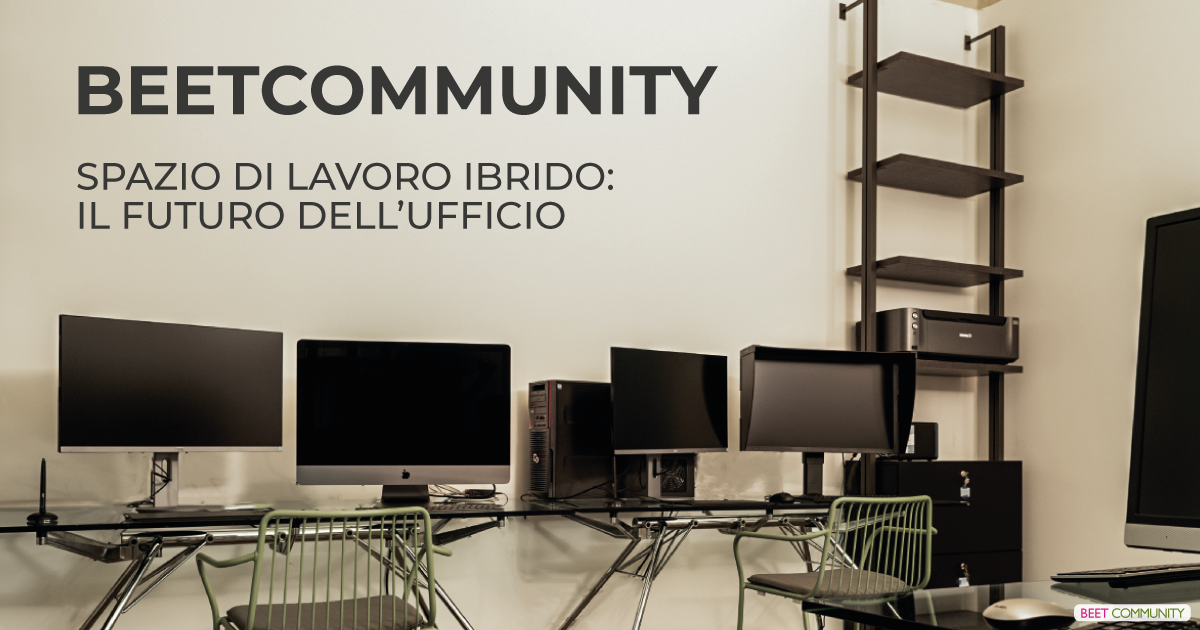[caption id="attachment_5855" align="aligncenter" width="1200"] The hybrid workplace is the new work model that combines remote work and in-person work. A solution born during the pandemic that represents the future of the office as we know it.[/caption]
The hybrid workplace is the new work model that combines remote work and in-person work. A solution born during the pandemic that represents the future of the office as we know it.[/caption]
The hybrid workplace is the new work model that combines remote work and in-person work. A solution born during the pandemic that represents the future of the office as we know it.
We’ve said it many times already:
the pandemic has completely changed the way we work. It’s true that the digital transformation of workspaces was already underway, but it was moving slowly and many companies and entrepreneurs struggled to imagine
a work model based on distance, flexibility, and the almost exclusive use of digital tools. But with the health emergency, adopting
smart working became the only possible and safe way to keep producing: the only defense against a virus that hit not only healthcare systems but also the economy, threatening to bring the whole world to collapse. Private companies, public institutions, employees, freelancers—everyone who either didn’t know or had prejudices about it had to adapt to
a work system where not only
physical presence isn’t necessary, but where
there’s no supervision, not even of working hours, because
the only thing that matters is the result, regardless of how or where it’s achieved.
The start of the hybrid workplace
After a revolution of this magnitude (not so much for the change itself, which was already happening, but for the speed with which it became part of daily life), it’s clear that once the Covid-19 emergency finally ends, we won’t simply go back to the old status quo.
Most likely,
what comes next won’t be the disappearance of the office as we know it
nor the full adoption of smart working. In fact, we’re already hearing about and seeing the first examples of
the hybrid workplace: a hybrid work model that mixes traditional office work with remote working, characterized by
a reduced number of in-office employees alternating with those working from home.
In the future, it will probably be up to each individual to choose, based on personal preferences, whether to work remotely temporarily or permanently, with work teams organized to best balance the two modes. Because
while smart working offers advantages like greater flexibility and improved employee well-being,
it also comes with unavoidable downsides in terms of social contact.
A hybrid solution that works for everyone
Not all workers like or can handle this new remote work environment in the long run. That’s why
transforming the work model into a hybrid one that combines the old and new modes seems the most functional and efficient.
Hybrid workplaces allow organizations and workers to enjoy both the benefits of remote work (lower overhead costs, more networking opportunities,
better work-life balance)
and the benefits of in-person work (easier access to certain resources, smoother coordination, face-to-face interaction during breaks). The key factor is that
the hybrid model combines remote and in-office work as needed, based on the needs and preferences of both workers and the company.
Overall, hybrid models will
multiply the solutions for smart work: more and more often, we’ll see
agreements between companies and providers of coworking spaces, coliving spaces and increasingly advanced digital tools to support optimal remote work.
The goal of creating hybrid workplaces is to maximize productivity, efficiency, and well-being for employees and to
promote a work culture based on collaboration between teams even if they’re located in different parts of the world.
But to ensure that such an ambitious project includes everyone, it’s crucial to remember how important it is for workers to feel comfortable, whether working from home or in the office. This means
giving both remote workers and in-office employees the same conditions and tools to work efficiently, with equal access to resources: high-performance computers, antivirus protection, software licenses, wireless mouse, keyboards and headphones, tablets, high-resolution webcams, cloud access, and instant messaging and video call platforms. Plus,
every team member must feel equally engaged in the life of the company and in the projects they’re working on, able to share ideas and collaborate without feeling the distance. The goal is
to remove blocks and disparities so that the whole team can work at the same speed, productivity, and comfort.
Of course,
equipping yourself with everything you need to work comfortably and efficiently from home can be costly for a company and challenging for remote workers who may be sharing space with roommates. That’s why we mentioned the potential of
partnering with coliving and coworking spaces. These spaces are designed to meet the needs of remote workers,
providing professionals with optimized workspaces equipped with both physical and digital infrastructure: ergonomic chairs, the right lighting, fast and secure wifi, fully-equipped computer workstations, flexible hours, access to key software, meeting rooms, and welcoming spaces to stretch your legs and chat during a break.
In short, these spaces offer everything you need to improve your comfort while working and avoid feeling isolated.
Take a look at our solutions and spaces—we’re sure you’ll find what you’re looking for. And if the frescoed ceilings and elegant design have caught your eye but you’re still not convinced, contact us and let’s chat!
>
 The hybrid workplace is the new work model that combines remote work and in-person work. A solution born during the pandemic that represents the future of the office as we know it.[/caption]
The hybrid workplace is the new work model that combines remote work and in-person work. A solution born during the pandemic that represents the future of the office as we know it.[/caption]




